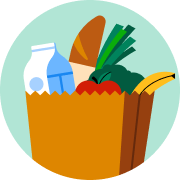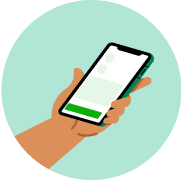
Fast delivery
Get in as fast as 1 hour

It’s all local
Shop your favorites

Direct chat
Connect with shoppers


About
Details
Sunny-Side UP Gardens Little Bunny Garden.
Includes everything to grow your veggie garden!
Directions
Growing instructions for your little bunny garden:
Your kit comes complete with an egg carton growing container, seeds, starter soil and a growing journal to record your garden as it grows!
Step 1: cut off the top of the egg carton, at the "hinge" and place underneath the bottom section as a tray to absorb any extra water as your plants grow.
Step 2: place soil pellets in a bowl (some pellets have netting - please remove netting & discard). Add about 1 cup of warm water. The pellets will turn into soil. Distribute evenly between the 12 growing compartments.
Step 3: divide each packet of seed between 2 growing compartments and plant. Cover the seeds lightly with soil. Water daily, being careful not to over water.
Step 4: use your pencil to write the plant names on your wooden ID stakes to identify your seeds.
Step 5: watch as your plants grow and record the progress on your growing journal sheet.
Step 6: when your seedlings are 3-4 inches tall (or 3 weeks old), transplant to a sunny location in the garden or large container. If the weather is not warm enough (70 degrees F/21 degrees C) to move outside, then simply transplant to a larger pot and place in a sunny window until the weather warms. To transplant, moisten the soil and gently handle the delicate plants, taking care not to damage the stems or roots while moving (most seedlings will release from the growing cell as one unit, held together by the roost), or you can cut or tear the individual cells and plant, being sure to tear a little off the bottom so the roots can easily expand.
Step 7: plants need elbow room! So now is a good time to thin your seedlings to just 3 or 4 plants per growing compartment. Do this by choosing the biggest, strongest and healthiest plants to keep. Clip off the remaining seedlings at the dirt level using a pair of sissors. Or, if you're careful, you can simply seperate individual seedlings when transplanting.
Step 8: it is important to feed your plants. After transplanting, use compost or fertilizer to maximize growth.
Transplanting instructions:
Wait until weather is warm to transplant seedlings outside in the ground or in containers.
Green (bush) beans:
Transplant and keep well watered. Beans will be ready to harvest in 4-5 weeks. Pick beans often to encourage continued flowering and production. These beans are a bush variety, so there is no need to trellis.
Carrots:
Choose deep, well-drained soil and plant seedlings. Keep soil hilled over the tops of roots to prevent greening. Carrots will be ready to harvest in 8-10 weeks.
Watermelon:
Plant both watermelon growing cells about 3 feet apart. Keep well watered. Watermelon will be ready to harvest in about 10-12 weeks. Harvest when the tendril on the vine nearest the fruit stem is dead or when the spot where the fruit rests on the ground is yellow.
Cucumbers:
Cucumbers will be ready to harvest in 5-6 weeks and vines can be trained to a fence or trellis to save garden space. Pick cucumbers daily to encourage continued production.
Yellow summer squash:
Plant both squash growing cells about 5 feet apart or in 2 containers, if "container gardening". Do not disturb the roots. Keep well watered. Squash will be ready to harvest in 5-6 weeks. Cut or twist off young squash at the size that you want. Harvest 2-3 times a week.
Radishes:
Transplant and keep well watered. Harvest in about 3 weeks when roots are the size of a large marble.
Warnings
Choking hazard - small parts. Not for children under 3 years old without adult supervision.
About
Details
Sunny-Side UP Gardens Little Bunny Garden.
Includes everything to grow your veggie garden!
Directions
Growing instructions for your little bunny garden:
Your kit comes complete with an egg carton growing container, seeds, starter soil and a growing journal to record your garden as it grows!
Step 1: cut off the top of the egg carton, at the "hinge" and place underneath the bottom section as a tray to absorb any extra water as your plants grow.
Step 2: place soil pellets in a bowl (some pellets have netting - please remove netting & discard). Add about 1 cup of warm water. The pellets will turn into soil. Distribute evenly between the 12 growing compartments.
Step 3: divide each packet of seed between 2 growing compartments and plant. Cover the seeds lightly with soil. Water daily, being careful not to over water.
Step 4: use your pencil to write the plant names on your wooden ID stakes to identify your seeds.
Step 5: watch as your plants grow and record the progress on your growing journal sheet.
Step 6: when your seedlings are 3-4 inches tall (or 3 weeks old), transplant to a sunny location in the garden or large container. If the weather is not warm enough (70 degrees F/21 degrees C) to move outside, then simply transplant to a larger pot and place in a sunny window until the weather warms. To transplant, moisten the soil and gently handle the delicate plants, taking care not to damage the stems or roots while moving (most seedlings will release from the growing cell as one unit, held together by the roost), or you can cut or tear the individual cells and plant, being sure to tear a little off the bottom so the roots can easily expand.
Step 7: plants need elbow room! So now is a good time to thin your seedlings to just 3 or 4 plants per growing compartment. Do this by choosing the biggest, strongest and healthiest plants to keep. Clip off the remaining seedlings at the dirt level using a pair of sissors. Or, if you're careful, you can simply seperate individual seedlings when transplanting.
Step 8: it is important to feed your plants. After transplanting, use compost or fertilizer to maximize growth.
Transplanting instructions:
Wait until weather is warm to transplant seedlings outside in the ground or in containers.
Green (bush) beans:
Transplant and keep well watered. Beans will be ready to harvest in 4-5 weeks. Pick beans often to encourage continued flowering and production. These beans are a bush variety, so there is no need to trellis.
Carrots:
Choose deep, well-drained soil and plant seedlings. Keep soil hilled over the tops of roots to prevent greening. Carrots will be ready to harvest in 8-10 weeks.
Watermelon:
Plant both watermelon growing cells about 3 feet apart. Keep well watered. Watermelon will be ready to harvest in about 10-12 weeks. Harvest when the tendril on the vine nearest the fruit stem is dead or when the spot where the fruit rests on the ground is yellow.
Cucumbers:
Cucumbers will be ready to harvest in 5-6 weeks and vines can be trained to a fence or trellis to save garden space. Pick cucumbers daily to encourage continued production.
Yellow summer squash:
Plant both squash growing cells about 5 feet apart or in 2 containers, if "container gardening". Do not disturb the roots. Keep well watered. Squash will be ready to harvest in 5-6 weeks. Cut or twist off young squash at the size that you want. Harvest 2-3 times a week.
Radishes:
Transplant and keep well watered. Harvest in about 3 weeks when roots are the size of a large marble.
Warnings
Choking hazard - small parts. Not for children under 3 years old without adult supervision.
Common questions
Learn more about how to place an order here.
Then, when you arrive at the store of your choice, use the Instacart app to notify us. Depending on the store, a shopper or store employee will bring the groceries to your car, or you can pick them up at the designated area.
Learn more about pickup orders here.
- Delivery fees start at $3.99 for same-day orders over $35. Fees vary for one-hour deliveries, club store deliveries, and deliveries under $35.
- Service fees vary and are subject to change based on factors like location and the number and types of items in your cart. Orders containing alcohol have a separate service fee.
- Tipping is optional but encouraged for delivery orders. It's a great way to show your shopper appreciation and recognition for excellent service. 100% of your tip goes directly to the shopper who delivers your order.
With an optional Instacart+ membership, you can get $0 delivery fee on every order over $35 and lower service fees too.
Instacart pickup cost:
- There may be a "pickup fee" (equivalent to a delivery fee for pickup orders) on your pick up order that is typically $1.99 for non-Instacart+ members. Instacart+ membership waives this like it would a delivery fee.
- Pick up orders have no service fees, regardless of non-Instacart+ or Instacart+ membership.
Learn more about Instacart pricing here.
You can set item and delivery instructions in advance, as well as chat directly with your shopper while they shop and deliver your items. You can tell the shopper to:
- Find Best Match: By default, your shopper will use their best judgement to pick a replacement for your item.
- Pick Specific Replacement: You can pick a specific alternative for the shopper to purchase if your first choice is out-of-stock.
- Don't Replace: For items you'd rather not replace, choose "Don't replace" to get a refund if the item is out of stock.
Learn more about instructions for specific items or replacements here.
- Missing items
- Incorrect items
- Damaged items
- Poor replacements
- Early/late orders
If an order never came, or you get someone else's order, you can reach out to Instacart Customer Experience.














































